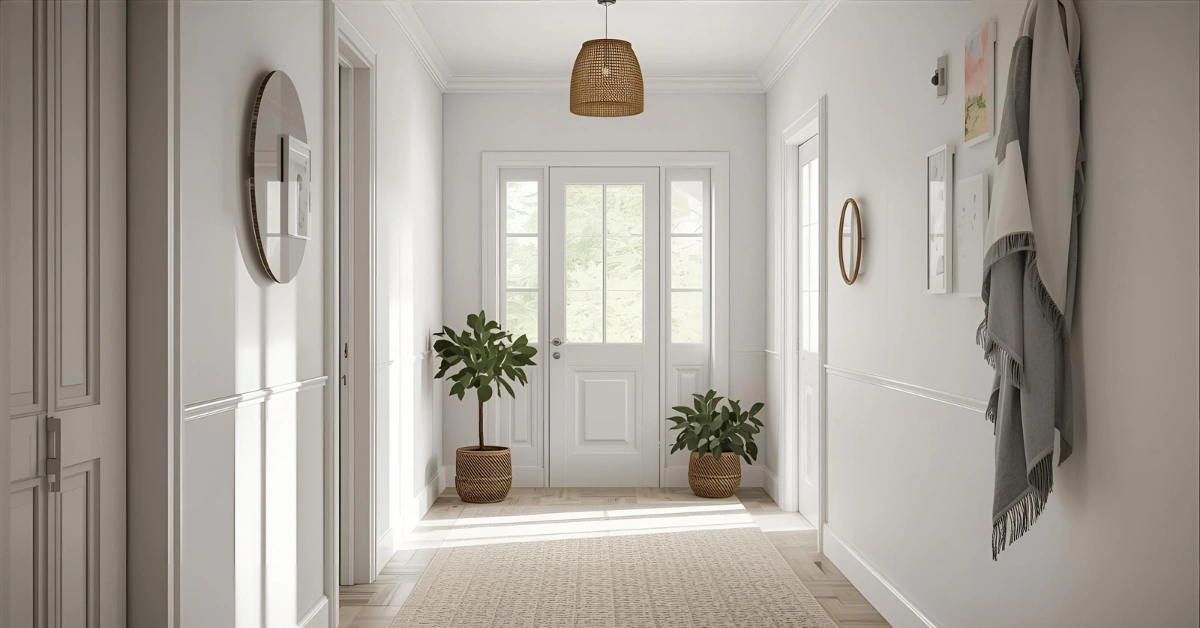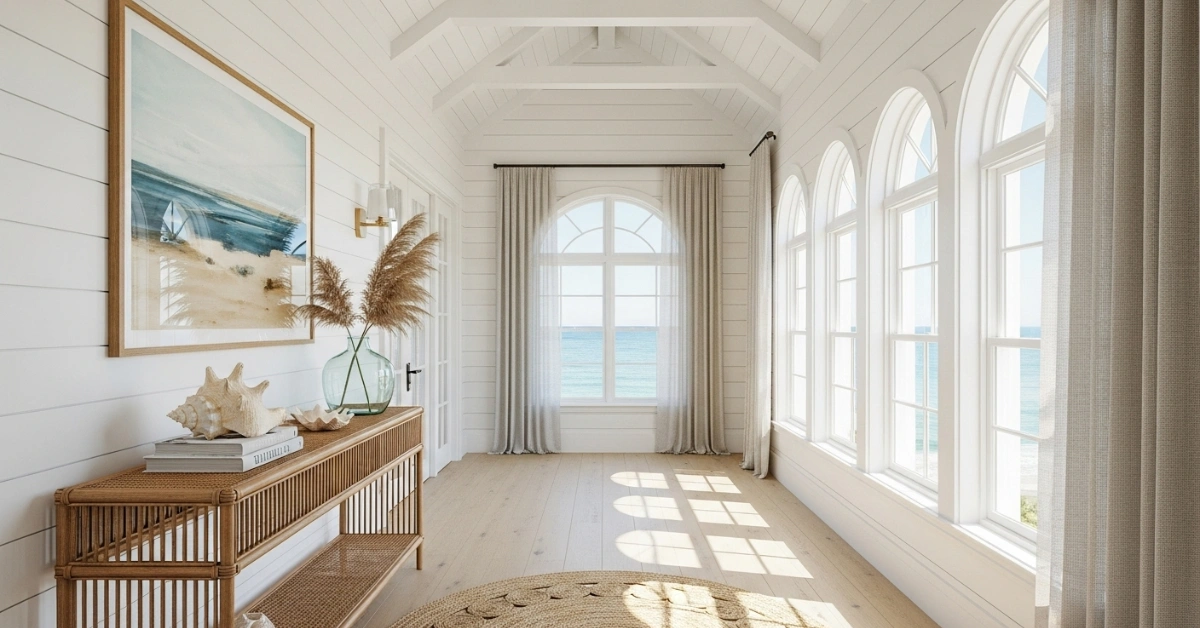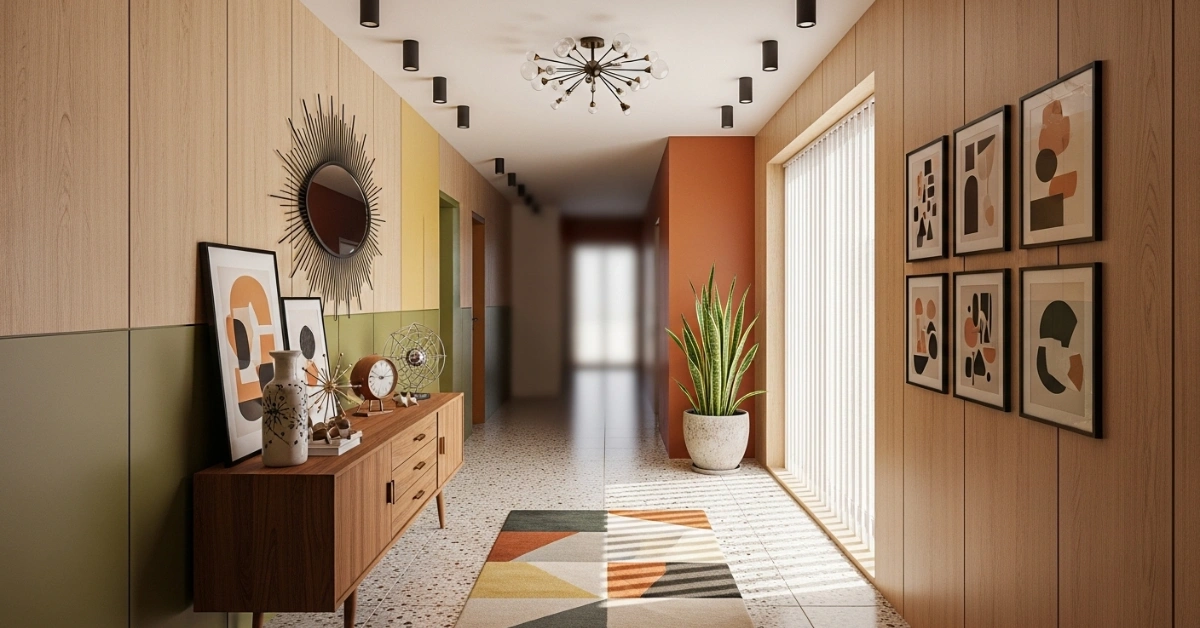Minimalist Hallway Design: 10 Tips for a Sleek Look

Your hallway is often the first impression guests have of your home, yet it’s frequently overlooked in design plans. A cluttered or uninspired hallway can feel chaotic, cramped, or uninviting, making your home seem less cohesive. For many homeowners, the challenge lies in balancing style, functionality, and simplicity in a space that’s typically narrow and high-traffic.
The solution? A minimalist hallway design. By embracing clean lines, neutral tones, and purposeful decor, you can create a hallway that’s both stylish and practical. This guide offers 10 actionable tips, expert insights, and inspiring ideas to help you craft a minimalist hallway that elevates your home’s aesthetic while maximizing space and utility. Whether you’re working with a narrow corridor or a grand entryway, these strategies will help you achieve a timeless, clutter-free look.
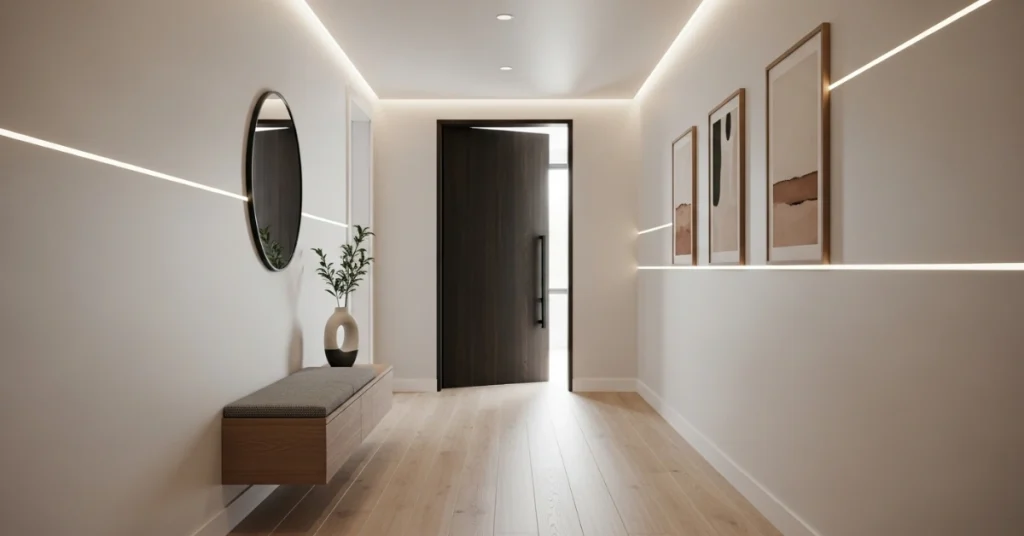
What Is a Minimalist Hallway?
Minimalism in interior design focuses on simplicity, functionality, and intentionality. A minimalist hallway strips away excess decor, prioritizes clean lines, and uses a restrained color palette to create a serene, welcoming space. According to the Metropolitan Museum of Art, minimalist design draws inspiration from mid-20th-century movements that valued form and function over ornamentation. In a hallway, this translates to sleek surfaces, purposeful furniture, and decor that serves both aesthetic and practical purposes.
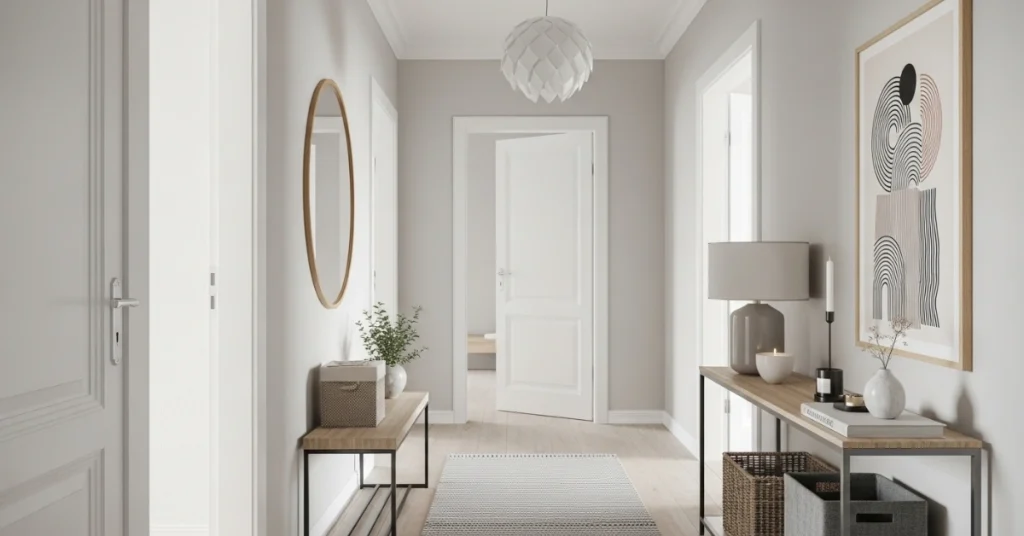
Key characteristics of a minimalist hallway include:
- Neutral color schemes: Whites, grays, beiges, or soft pastels.
- Decluttered spaces: Only essential items are included.
- Functional design: Storage solutions and furniture that serve a purpose.
- Natural light: Maximizing light to enhance openness.
Why Choose Minimalism for Your Hallway?
A minimalist hallway offers several benefits:
- Visual calm: A clutter-free space feels soothing and inviting.
- Space efficiency: Perfect for narrow or small hallways.
- Timeless appeal: Minimalist designs rarely go out of style.
- Ease of maintenance: Fewer items mean less cleaning and upkeep.
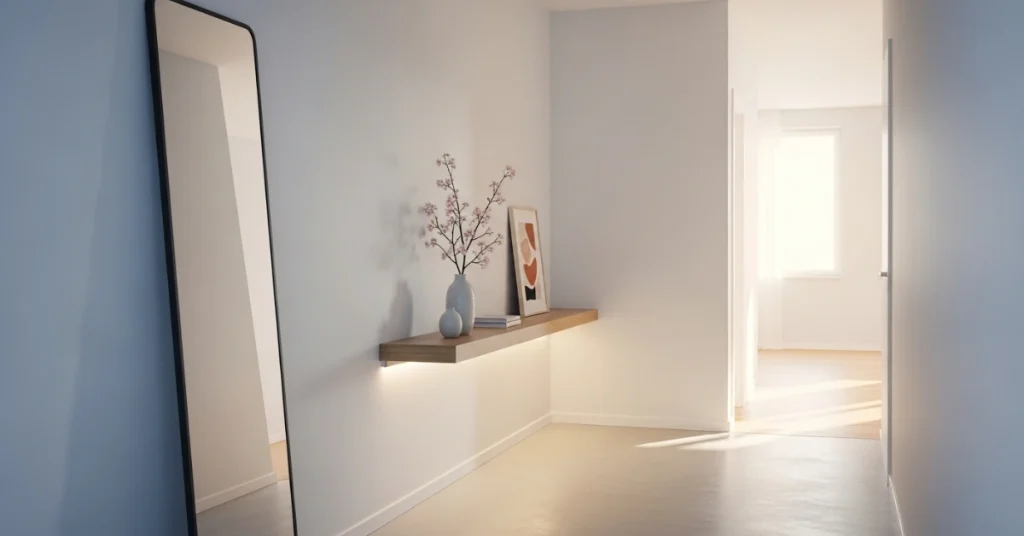
As interior designer Sarah Johnson notes, “A minimalist hallway sets the tone for the rest of the home. It’s about creating a space that feels open and intentional, no matter its size.”
Step 1: Plan Your Minimalist Hallway Design
Before diving into decor, take time to plan your hallway’s layout and purpose. A well-thought-out design ensures every element serves a function while maintaining a clean aesthetic.
Assess Your Space
Measure your hallway’s dimensions and note any architectural features, such as doors, windows, or alcoves. Consider the following:
- Traffic flow: Is it a high-traffic area connecting multiple rooms?
- Lighting: Are there windows, or will you rely on artificial light?
- Storage needs: Do you need space for shoes, coats, or keys?

For example, in my own home, I transformed a narrow 10-foot hallway by mapping out where a slim console table could fit without obstructing movement. This small step made a big difference in keeping the space functional yet uncluttered.
Set a Clear Vision
Define the vibe you want. Are you aiming for a Scandinavian-inspired minimalist hallway with warm wood accents or a sleek, modern look with glossy finishes? Write down your goals to stay focused during the design process.
Create a Mood Board
Collect inspiration from platforms like Pinterest or design magazines. Include images of minimalist hallways that resonate with you, noting colors, textures, and furniture. This helps visualize your end goal and ensures consistency.
Step 2: Choose a Minimalist Color Palette
Color plays a pivotal role in creating a minimalist hallway. Stick to a neutral or monochromatic palette to maintain a cohesive, calming effect.
Best Colors for a Minimalist Hallway
- White: Brightens small spaces and creates a clean backdrop.
- Soft Gray: Adds sophistication without overwhelming.
- Beige or Taupe: Warms up the space while staying neutral.
- Black Accents: Use sparingly for contrast, such as in frames or hardware.
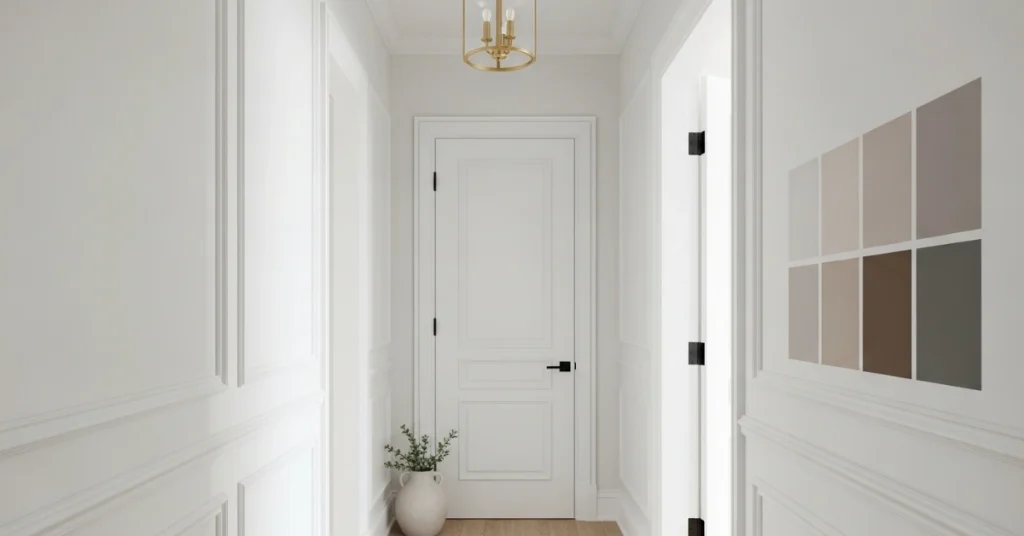
Interior designer Emily Chen advises, “In a minimalist hallway, color should enhance the space, not dominate it. Stick to one or two hues and let textures add depth.”
Tips for Implementing Your Palette
- Paint walls and trim: Use a single color for walls and trim to create a seamless look.
- Incorporate subtle accents: Add pops of color through small decor items, like a vase or rug.
- Test samples: Paint swatches on your walls to see how they look under your hallway’s lighting.
For instance, in a recent project, a homeowner painted their hallway walls and ceiling in a soft matte white, which made the space feel larger and more open. A single black-framed mirror added a touch of contrast without disrupting the minimalist vibe.
Step 3: Maximize Lighting in Your Hallway
Lighting is crucial in a minimalist hallway, as it enhances the sense of space and highlights the clean design.
Natural Light
If your hallway has windows, keep them uncovered or use sheer curtains to allow maximum light. Mirrors can also reflect natural light, making the space feel brighter and larger.
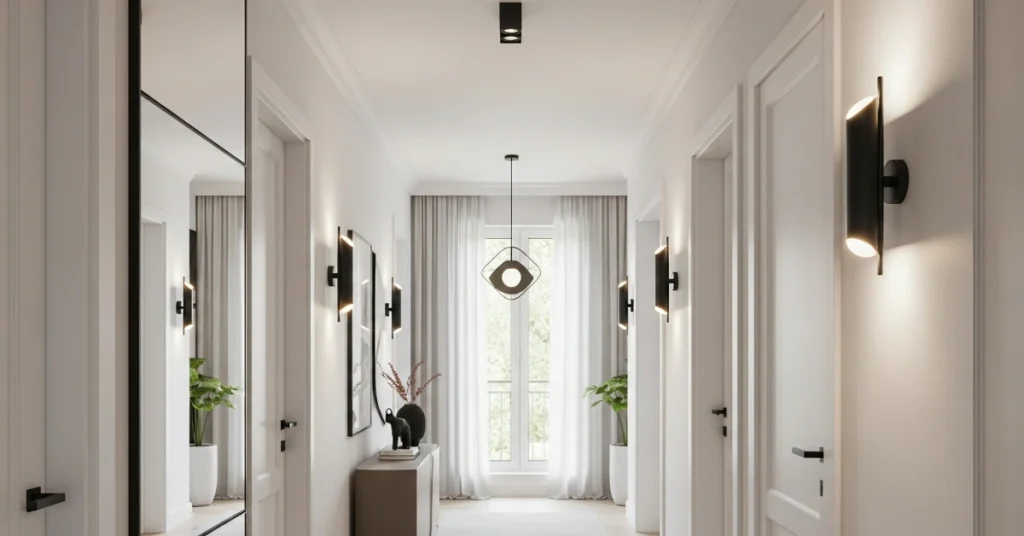
Artificial Lighting Options
- Recessed lighting: Provides even illumination without cluttering the ceiling.
- Wall sconces: Sleek, space-saving, and stylish.
- Pendant lights: Ideal for larger hallways; choose simple, geometric designs.
Pro Tip: Opt for warm LED bulbs (2700K–3000K) to create a cozy yet modern ambiance.
Real-World Example
In a client’s home, we installed two minimalist wall sconces with brushed nickel finishes in a narrow hallway. Paired with a large mirror, the lighting made the space feel airy and inviting, even at night.
Step 4: Select Functional Furniture
Minimalist hallways require furniture that’s both stylish and practical. Avoid overcrowding the space with unnecessary pieces.
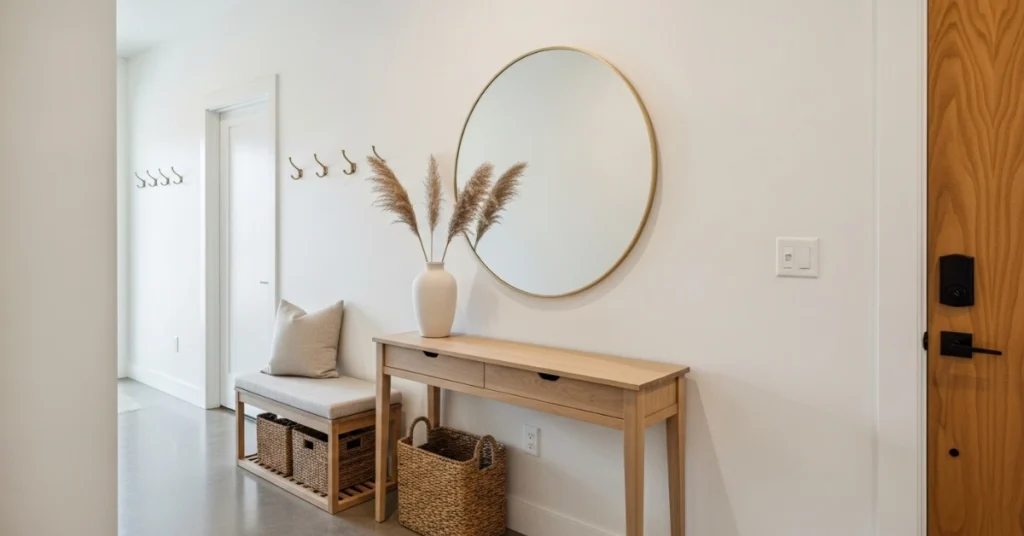
Must-Have Furniture for a Minimalist Hallway
| Furniture | Purpose | Minimalist Design Tip |
|---|---|---|
| Console Table | Storage and decor display | Choose a slim table with clean lines. |
| Wall Hooks | Coat and bag storage | Opt for sleek, metallic hooks. |
| Bench | Seating for shoe removal | Select a low-profile bench with hidden storage. |
| Floating Shelves | Display or storage | Use simple wood or metal shelves for a airy feel. |
Tips for Choosing Furniture
- Scale matters: Ensure furniture fits the hallway’s dimensions without blocking pathways.
- Multi-purpose pieces: Look for items like a bench with built-in shoe storage.
- Neutral materials: Wood, metal, or glass in neutral tones work best.
Designer Mark Thompson shares, “In a minimalist hallway, every piece should earn its place. A single, well-chosen console table can serve as both storage and a statement piece.”
Step 5: Incorporate Smart Storage Solutions
Storage is essential in a minimalist hallway to keep clutter at bay. The key is to integrate storage seamlessly into the design.
Storage Ideas
- Built-in cabinets: Sleek, handle-less cabinets blend into the walls.
- Shoe racks: Slim, vertical racks save floor space.
- Wall-mounted baskets: Perfect for keys, mail, or small items.
- Under-bench storage: Use baskets or boxes under a bench for hidden storage.
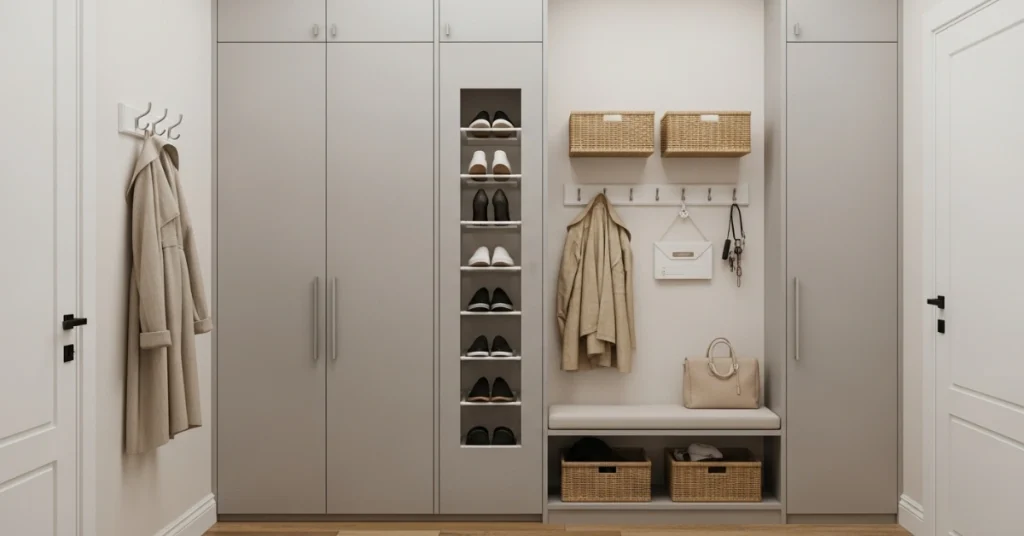
Practical Example
In a small apartment hallway, we installed a row of minimalist wall hooks and a slim shoe rack beneath a floating console. This setup kept the space organized without sacrificing style, proving that even tiny hallways can be both functional and beautiful.
Step 6: Add Thoughtful Decor
Minimalist decor is about quality over quantity. Choose a few impactful pieces that enhance the space without overwhelming it.
Decor Ideas for a Minimalist Hallway
- Mirrors: A large, simple mirror adds depth and reflects light.
- Artwork: One or two pieces with clean lines or abstract designs.
- Plants: A single potted plant, like a snake plant or monstera, adds life.
- Rugs: A neutral runner with subtle patterns adds warmth.
Tips for Decorating
- Keep it simple: Limit decor to 2–3 items to avoid clutter.
- Choose timeless pieces: Opt for classic designs that won’t date quickly.
- Maintain proportion: Ensure decor fits the hallway’s scale.
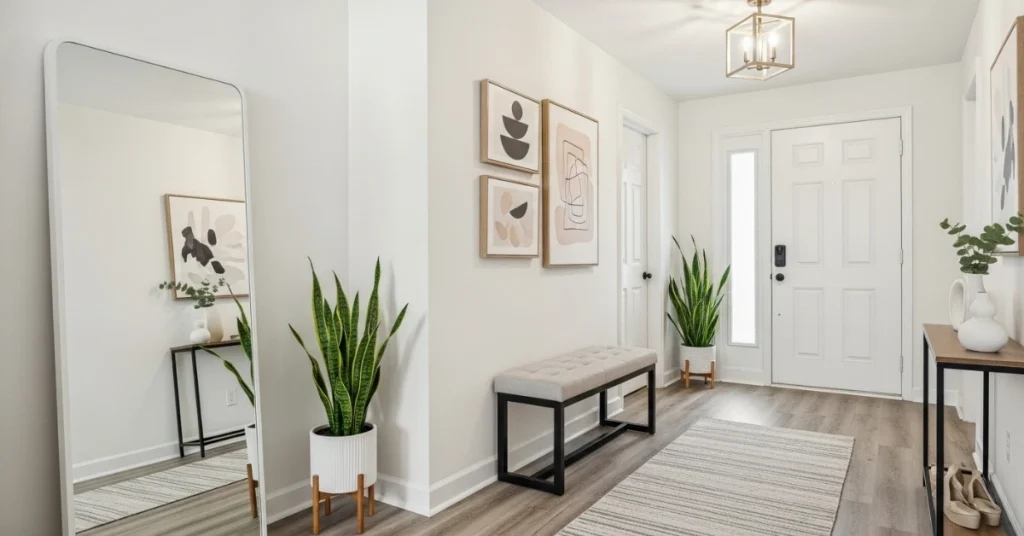
For example, in my own hallway, I added a single large round mirror and a small potted plant on a console table. The simplicity kept the space feeling open while adding personality.
Step 7: Maintain Your Minimalist Hallway
A minimalist hallway requires regular upkeep to stay clutter-free and visually appealing.
Maintenance Tips
- Declutter regularly: Clear out items like stray shoes or mail weekly.
- Clean surfaces: Wipe down mirrors, tables, and shelves to maintain a polished look.
- Rotate decor: Swap out small decor items seasonally to keep the space fresh.
- Check lighting: Replace bulbs promptly to ensure consistent illumination.

Interior designer Laura Bennett advises, “A minimalist hallway thrives on discipline. Regularly assess what’s in the space and remove anything that doesn’t belong.”
Common Mistakes to Avoid
Even with the best intentions, it’s easy to stray from minimalist principles. Here are pitfalls to watch out for:
- Over-decorating: Too many items can make the space feel cluttered.
- Ignoring scale: Oversized furniture can overwhelm a narrow hallway.
- Poor lighting: Dim lighting makes the space feel cramped.
- Clashing colors: Stick to a cohesive palette to maintain harmony.
Inspiration: Real Minimalist Hallway Examples
- Scandinavian Style: A white hallway with light wood floors, a slim oak console, and a single black-framed mirror. A woven runner adds texture.
- Modern Industrial: Gray walls, black metal hooks, and a concrete-look console table create a sleek, urban vibe.
- Cozy Minimalist: Beige walls, a low bench with cushions, and a potted plant for warmth and simplicity.

These examples show how versatile minimalist hallway designs can be, adapting to various styles while maintaining a clean aesthetic.
Conclusion: Transform Your Hallway with Minimalist Design
A minimalist hallway is more than just a passageway, it’s an opportunity to create a welcoming, functional, and stylish introduction to your home. By focusing on clean lines, neutral colors, and purposeful decor, you can craft a space that’s both beautiful and practical. Whether you’re starting from scratch or refreshing an existing hallway, the tips and ideas in this guide will help you achieve a timeless, clutter-free look.
Ready to transform your hallway? Start by assessing your space and choosing one or two elements to implement today, like a sleek console table or a statement mirror. For more inspiration, explore minimalist design blogs or consult a local interior designer to bring your vision to life.

